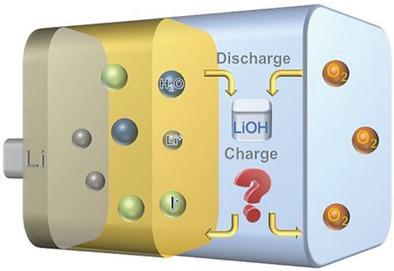当前位置:
X-MOL 学术
›
Adv. Mater.
›
论文详情
Our official English website, www.x-mol.net, welcomes your
feedback! (Note: you will need to create a separate account there.)
Understanding the Role of Lithium Iodide in Lithium–Oxygen Batteries
Advanced Materials ( IF 27.4 ) Pub Date : 2021-12-02 , DOI: 10.1002/adma.202106148 Xuanxuan Bi 1 , Jiantao Li 1 , Mouad Dahbi 2 , Jones Alami 2 , Khalil Amine 1, 3 , Jun Lu 1
Advanced Materials ( IF 27.4 ) Pub Date : 2021-12-02 , DOI: 10.1002/adma.202106148 Xuanxuan Bi 1 , Jiantao Li 1 , Mouad Dahbi 2 , Jones Alami 2 , Khalil Amine 1, 3 , Jun Lu 1
Affiliation

|
Lithium–oxygen (Li–O2) batteries possess a high theoretical energy density, which means they could become a potential alternative to lithium-ion batteries. Nevertheless, the charging process of Li–O2 batteries requires much higher energy, due to the insulating nature of the discharge product. It has been revealed that the anion additive, lithium iodide (LiI), can tune the cell chemistry to form lithium hydroxide (LiOH) as the product and facilitate the kinetics during the charging process. Although numerous studies have been reported, the role of this additive is still under investigation. Herein, the recent advances focusing on the use of LiI in Li–O2 batteries are reviewed, its catalytic behavior on discharge and charge is discussed, and its synergistic effect with water is understood. The ambiguity existing among the studies are also revealed, and solutions to the current issues are introduced.
中文翻译:

了解碘化锂在锂氧电池中的作用
锂氧(Li-O 2)电池具有较高的理论能量密度,这意味着它们可以成为锂离子电池的潜在替代品。尽管如此,由于放电产物的绝缘性,Li-O 2电池的充电过程需要更高的能量。据透露,阴离子添加剂碘化锂 (LiI) 可以调整电池化学成分以形成氢氧化锂 (LiOH) 作为产物,并促进充电过程中的动力学。尽管已经报道了许多研究,但这种添加剂的作用仍在研究中。在此,最近的进展侧重于在 Li-O 2 中使用 LiI回顾了电池,讨论了其对放电和充电的催化行为,并了解了其与水的协同作用。还揭示了研究之间存在的歧义,并介绍了当前问题的解决方案。
更新日期:2022-01-07
中文翻译:

了解碘化锂在锂氧电池中的作用
锂氧(Li-O 2)电池具有较高的理论能量密度,这意味着它们可以成为锂离子电池的潜在替代品。尽管如此,由于放电产物的绝缘性,Li-O 2电池的充电过程需要更高的能量。据透露,阴离子添加剂碘化锂 (LiI) 可以调整电池化学成分以形成氢氧化锂 (LiOH) 作为产物,并促进充电过程中的动力学。尽管已经报道了许多研究,但这种添加剂的作用仍在研究中。在此,最近的进展侧重于在 Li-O 2 中使用 LiI回顾了电池,讨论了其对放电和充电的催化行为,并了解了其与水的协同作用。还揭示了研究之间存在的歧义,并介绍了当前问题的解决方案。











































 京公网安备 11010802027423号
京公网安备 11010802027423号